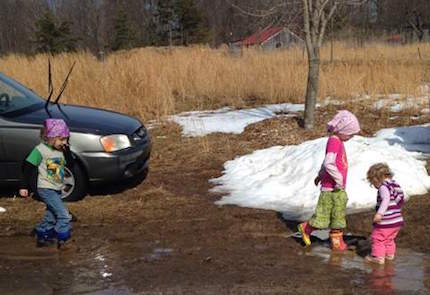
Winter is on the wane at last. On Sunday morning, 13 of us, seven adults and six children and babies, took a walk eastward up Peachey Trace into the bare-branched woods and over to the clearing known as Hunters' Field. We were giddy with the laugh-out-loud happiness of being out of our houses, liberated from days of confinement by snow and ice. The white stuff still shushed and crunched under our feet, but it hardly reached the tops of our sturdy shoes. Lingering small icy stretches made us use our walking sticks, grabbed off the porch at Foxfire as we went by. Our progress was slow. The children wanted to touch the textured bark of trees, peer intently at fallen twigs, wander into the pale winter field grass, and sit down on the intriguing ground.
What is it about young humans and the earth? Every manifestation of dirt, soil, sand, humus, and clay draws them; perhaps particularly when another of earth's elements, water, adds it magic. Then the sploshy, slippery, gurgly, damp feel, sound, and smell of mud is irresistible. On Monday, Kate sent round pictures of Wren, Emma, and Ana dancing in the dark, thick puddles of the dirt lane that connects our homes.
Mist formed Wednesday morning, born of the warm, moist air and the cool, loamy earth. It rose among the bare, dark trees and twisted fallen branches of the winter-worn woods. Suspended there, delicately, neither water nor air, it was an invitation to the world of in-between, where boundaries melt. Walking into this world on the cusp of spring is like entering a cathedral of sensation. Birdsong reverberates aloft, while the ground gives and undulates underfoot. Scents of wet leaves and the musk of damp earth waft through the dripping air. Flashes of a woodpecker's wing and the scampering dance of a squirrel tease the eye. All around the forest is stirring, rustling: emanating presence and welcome and awakening.
It's a curious thing, this swirl of sensation, this sense of connection and belonging, this deep affection. Because this patch of earth's garden we call Rolling Ridge is not observably remarkable or attractive. It is a humble mountain, a foothill. Its woods are filled with fallen trees and branches; tangled and prickly bushes; rocky soil; modest creeks and streams. Nevertheless, it calls us.
It calls us, I am coming to understand, not through some esoteric, spiritual power, nor through compelling beauty, but through being itself, being present and alive. I've been reading David Abram, who in Becoming Animal writes, "We can sense the world around us only because we are entirely a part of this world, because-by virtue of our own carnal density and dynamism-we are wholly embedded in the depths of the earthly sensuous. We can feel the tangible textures, sounds, and shapes of the biosphere because we are tangible, resonant, audible shapes in our own right. We are born of these very waters, this very air, this loamy soil, this sunlight...."
It's a busy season around here. We are preparing for a spring work day: there is a garden to be planted, a retreat house to be cleaned, wood to be gathered, cut, and stacked, guests to be hosted, retreats and events to be carried out; and of course, jobs to go to, children to raise. It is easy to get unmoored, to zing from task to task, to forget where we belong.
Yet we only have to walk out on a sunny or misty morning and let the forest happen around us. It doesn't take knowing much, or even great mindfulness. It takes skin, a nose, eyes, ears, a good pair of shoes, a willingness to laugh, to sit down in the mud; to feel the earth; and we are again entirely a part of this world.